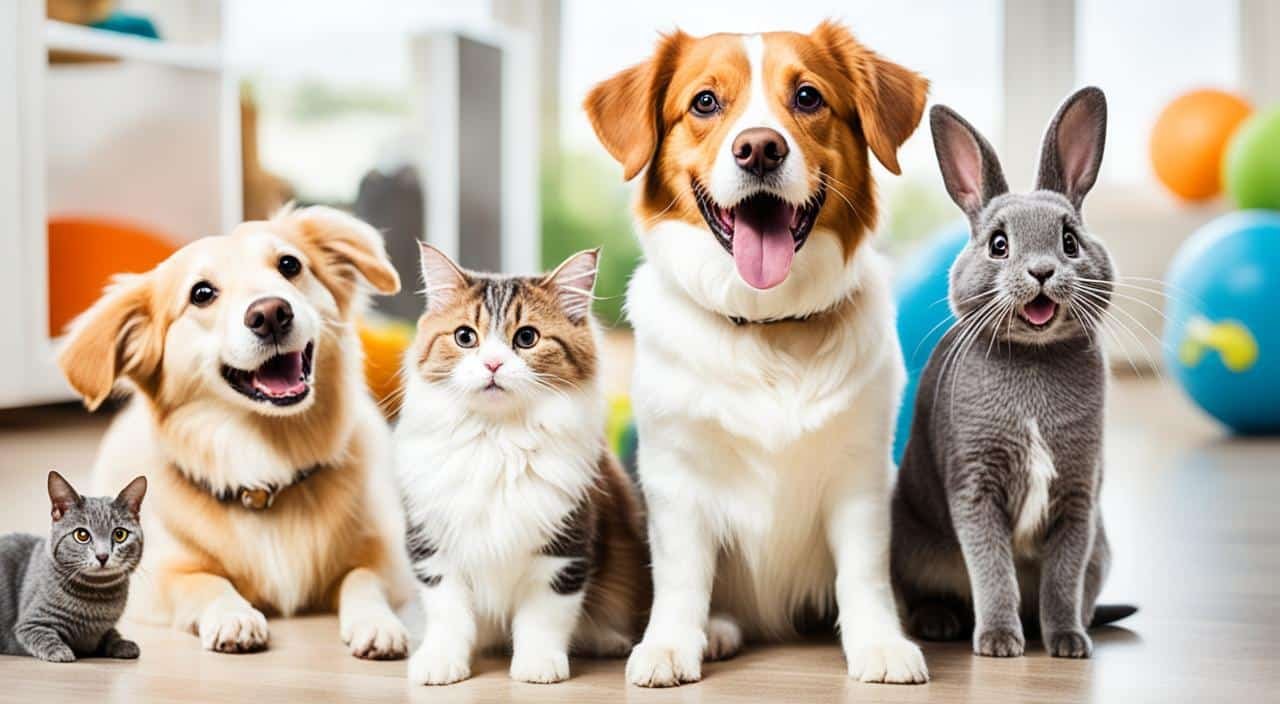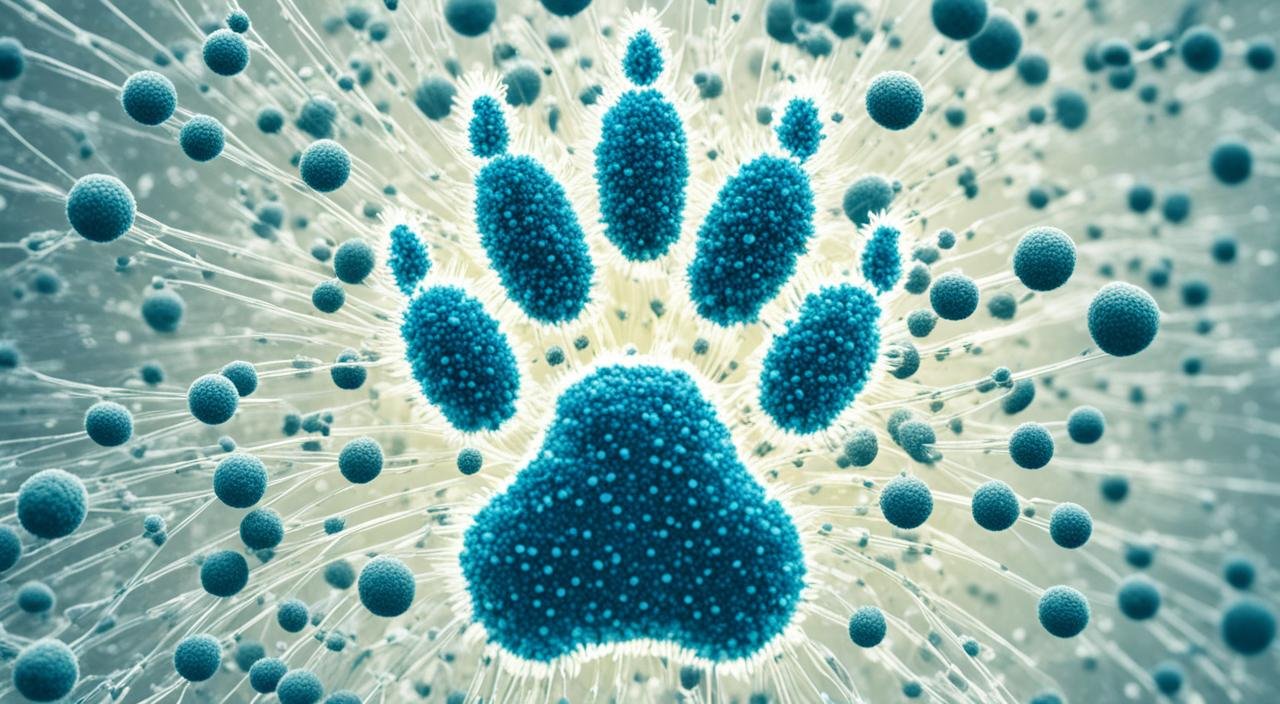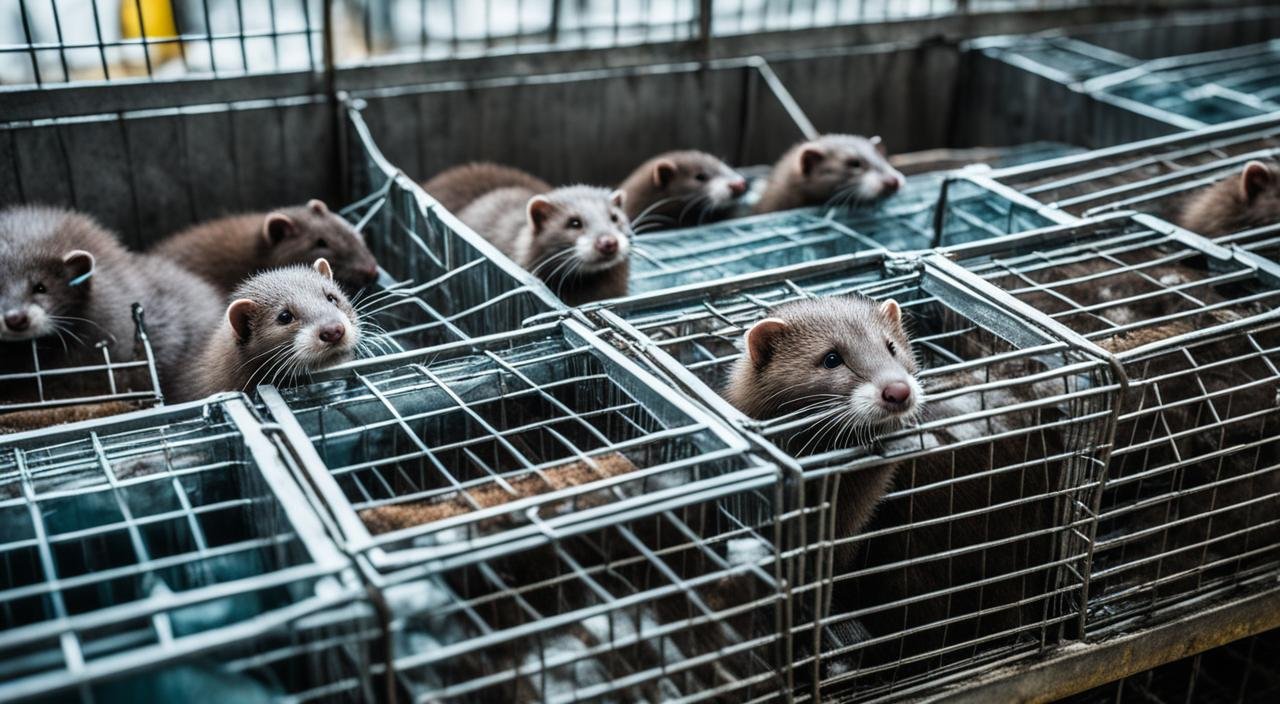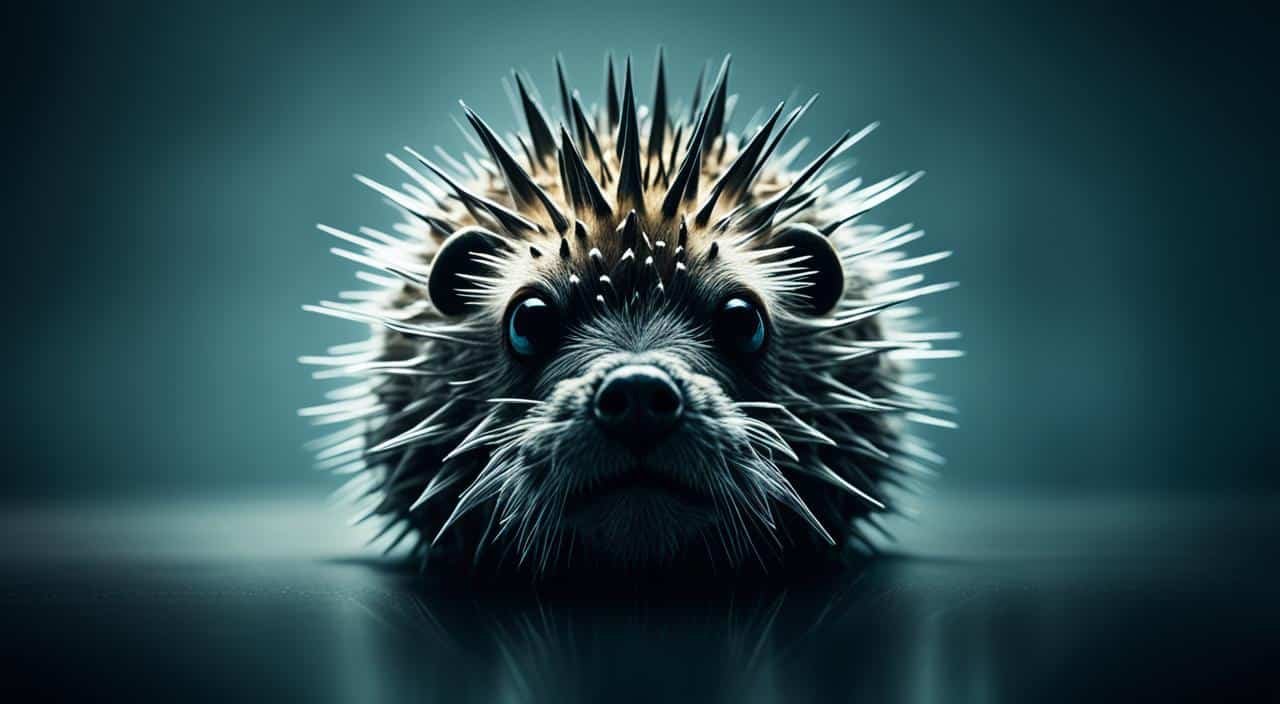The COVID-19 pandemic has made us worry about how it affects pets and other animals. The virus behind COVID-19, SARS-CoV-2, can infect many animals, including dogs, cats, mink, and farm animals. While it’s rare for animals to spread the virus to people, there have been cases, especially on mink farms.
It’s important to know how the virus affects animals to keep both people and animals safe. This article will look into the latest research on how pets and animals are affected by the virus. We’ll also talk about how to stop diseases from moving from animals to humans.
Key Takeaways
- Coronaviruses can infect a range of animal species, including pets like dogs and cats.
- While the risk of pets spreading COVID-19 to humans is considered low, there have been reported cases of animal-to-human transmission, particularly in the context of mink farms.
- Monitoring and research efforts are underway to better understand the coronavirus’s impact on animals and prevent potential zoonotic transmission.
- Precautions and protective measures for pet owners with COVID-19 are important to safeguard both human and animal health.
- The pandemic has highlighted the need for increased cooperation between public health authorities, veterinary experts, and the scientific community to address emerging infectious diseases that can cross the human-animal divide.
Understanding Coronaviruses and Their Transmission
Coronaviruses are a big family of viruses that can affect humans and animals. These viruses cause a variety of illnesses, from mild colds to severe diseases. The virus causing COVID-19, known as SARS-CoV-2, is part of this group.
Coronaviruses: A Family of Viruses
Coronaviruses are related RNA viruses that can infect humans, animals, and birds. Some affect animals mainly, while others, like the COVID-19 virus, can spread from animals to humans and then between people.
SARS-CoV-2: The Virus Behind COVID-19
SARS-CoV-2, the virus causing COVID-19, likely came from bats and then moved to humans, possibly through another animal. It spreads through respiratory droplets when an infected person coughs, sneezes, or talks. It can also spread between people and animals, but this is less common.
| Key Characteristics | SARS-CoV-2 |
|---|---|
| Virus Type | Coronavirus |
| Disease Caused | COVID-19 |
| Likely Animal Origin | Bats |
| Transmission Routes | Respiratory droplets, person-to-person, potential animal-to-human |
Knowing about coronaviruses and SARS-CoV-2 helps us fight COVID-19. It’s key to controlling the spread of the virus in humans and animals.
Also Read :What Are The Types Of Business Insurance?
Can Pets Contract Coronavirus?

The COVID-19 pandemic has made us wonder if our pets can get the virus. Studies show that some pets like dogs, cats, hamsters, and ferrets can catch SARS-CoV-2. This is the virus that causes COVID-19 in humans.
Companion Animals Susceptible to COVID-19
It’s thought that pets are unlikely to spread the virus to people. But, pets can pass the virus to their owners or those who take care of them. This usually happens when pets are close to people with COVID-19.
The Centers for Disease Control and Prevention (CDC) say the following pets can get the virus that causes COVID-19:
- Dogs
- Cats
- Hamsters
- Ferrets
Pets are not all equally likely to get SARS-CoV-2. Not all will get sick, and most won’t show many symptoms. But, pets with health issues might get very sick.
| Companion Animal | Susceptibility to SARS-CoV-2 |
|---|---|
| Dogs | Low to moderate |
| Cats | Moderate to high |
| Hamsters | High |
| Ferrets | High |
As the pandemic goes on, it’s key for pet owners to know the risks. They should take steps to keep their pets safe.
Also Read :What Are The Benefits Of Pet Insurance?
Coronavirus Transmission from Pets to Humans

The risk of pets spreading COVID-19 to their owners is low. But, there have been cases where pets like mink, hamsters, and cats passed the virus to people. Experts say it’s much more likely to get COVID-19 from another person than from a pet.
Pets can catch the SARS-CoV-2 virus that causes COVID-19. But, it’s rare for them to pass it to their owners. This is known as zoonotic transmission.
Several factors make it unlikely for pets to spread the virus to humans:
- Pets usually don’t get very sick from the virus and have less of it in their bodies.
- They don’t usually spend as much time close to their owners as humans do with each other.
- Good hygiene, like washing hands and cleaning, helps lower the risk of getting the virus from pets.
Even though the risk is low, pet owners should still be careful to keep their pets and themselves safe during the COVID-19 pandemic. Knowing the risks helps pet owners make smart choices to protect everyone.
“While the risk of pets spreading COVID-19 to their owners is relatively low, it’s still important for pet owners to take precautions to protect themselves and their animals.”
Also Read : What Foods Should You Avoid With High Blood Pressure?
Protecting Your Pets During the Coronavirus Pandemic
As the COVID-19 pandemic continues, pet owners must act to keep their pets safe. The risk of pets getting the virus is low. Yet, it’s key to take steps to protect them and stop the virus from spreading.
Precautions for Pet Owners with COVID-19
If you have COVID-19, keep your distance from your pets. Don’t pet, kiss, or share food with them. Always wear a face mask when you do interact with them. Washing your hands often is also crucial to keep the virus from spreading to your pets.
If your pet gets the coronavirus, call your vet right away. They can give you advice on how to care for your pet. This will help keep your pet healthy during this tough time.
Putting the safety of you and your pets first is important. By following these steps, you can keep your pets safe. This also helps in fighting the spread of COVID-19.
“The health and safety of our pets should be a top concern during this pandemic. By taking the necessary precautions, we can ensure that our beloved companions remain safe and healthy.”
| Precaution | Description |
|---|---|
| Minimize contact with pets | Avoid petting, kissing, or sharing food with your pets if you have COVID-19. |
| Wear a face mask | Wear a face mask when interacting with your pets to prevent virus transmission. |
| Frequent handwashing | Wash your hands frequently, especially before and after handling your pets. |
| Contact your veterinarian | If your pet becomes infected, contact your veterinarian for guidance on care and treatment. |
Mink Farms and Coronavirus Outbreaks

During the COVID-19 pandemic, mink farms became a big worry. Minks easily catch the SARS-CoV-2 virus, causing big outbreaks on farms worldwide. This has made people worry about the risk of the virus moving from minks to humans.
Also Read :What Are The Fees And Interest Rates For Payday Loans?
Mink-to-Human Transmission Concerns
There have been cases where the virus moved from minks to people. Workers on mink farms got the virus, showing the danger of animals giving it to humans. The virus might change in minks, making new versions that could spread more easily or be harder to fight with vaccines.
| Country | Mink Farm Outbreaks | Reported Mink-to-Human Transmission |
|---|---|---|
| Denmark | Yes | Yes |
| Netherlands | Yes | Yes |
| Spain | Yes | Yes |
| United States | Yes | Yes |
To lower the risks from mink farms, governments and health groups have taken steps. They’ve killed infected minks, made farms safer, and watched these places closely for any virus signs or changes.
“The potential for further spread of this virus from mink to humans is a serious concern, and we need to take it very seriously.”
–World Health Organization
Also Read :How Do I Choose The Right Small Business Insurance Policy?
Wildlife and Coronavirus Infections

The COVID-19 pandemic has hit not just domestic and farm animals but also wild ones. From big cats in zoos to deer, the virus can infect many animals. This raises big worries about the virus staying in wildlife.
Though the risk of animals giving the virus to humans is low, the issue is still serious. As humans move closer to nature, the chance of diseases moving from animals to humans grows. This is a big concern.
The Susceptibility of Wild Animals
Studies now show many wild animals, like big cats, deer, and mink, can get SARS-CoV-2. This is because the virus can attack the angiotensin-converting enzyme 2 (ACE2) receptors in these animals. These receptors help the virus get into cells.
Finding COVID-19 in wild animals means we need to watch them closely. We must learn how widespread the virus is in these groups. This is key to stopping zoonotic diseases from happening again.
Safeguarding Wildlife and Human Health
Studying COVID-19 in wildlife shows we need a One Health approach. This means working together to keep humans, animals, and the environment healthy. Experts from different fields must work together to stop zoonotic diseases.
Knowing how wildlife reacts to COVID-19 and other diseases helps us protect everyone. This way, we can keep both animals and humans safe for the future.
| Animal Species | Susceptibility to COVID-19 |
|---|---|
| Big Cats (Lions, Tigers, Etc.) | Confirmed positive cases in zoos |
| White-tailed Deer | Reported positive cases in wild populations |
| Mule Deer | Reported positive cases in wild populations |
| Mink | Outbreaks on fur farms, with potential for mink-to-human transmission |
“The discovery of COVID-19 infections in wild animals highlights the need for increased surveillance and research to understand the extent of viral spread among these populations.”
Coronavirus Variants and Their Impact on Animals

New virus variants have appeared during the COVID-19 pandemic, worrying about their effect on animals. These changes can make the virus spread more easily among animals or to humans. We need to keep a close watch and study this to grasp how it might affect animals and human health.
The virus variants like Alpha, Beta, Gamma, and Delta are more contagious and can dodge some immune responses. This has made us worry about how animals might get infected and how the virus could change in animals.
Some animals, like domestic cats, ferrets, and mink, can catch SARS-CoV-2. This means they could pass it to humans. We’re studying how the virus moves in animals and its effects on public health.
| Variant | Characteristics | Animal Susceptibility |
|---|---|---|
| Alpha | Increased transmissibility | Cats, ferrets, mink |
| Beta | Increased immune evasion | Cats, ferrets, mink |
| Gamma | Increased transmissibility and immune evasion | Cats, ferrets, mink |
| Delta | Increased transmissibility and immune evasion | Cats, ferrets, mink |
It’s important to keep an eye on virus mutations and their effects on animal susceptibility and virus transmission. By doing so, we can get ready and lessen the risks of coronavirus variants and their links with animals.
“Understanding the impact of coronavirus variants on animals is crucial for safeguarding public health and preventing future zoonotic outbreaks.”
Monitoring and Preventing Zoonotic Transmission

To fight the risks of zoonotic transmission of COVID-19 and other diseases, health experts, vets, and scientists are working together. They focus on virus surveillance and research efforts. They watch how the virus moves from animals to humans and study its genetic makeup to learn how it changes and affects health.
The “One Health” idea is key for tackling zoonotic diseases. It sees the link between human, animal, and environmental health. This helps in making plans to stop and handle disease outbreaks. By using epidemiological data and advanced virus monitoring, scientists can learn how zoonotic diseases spread. They can then make specific plans to lower risks.
Surveillance and Research Efforts
Worldwide, virus surveillance programs are set up to track COVID-19 and other zoonotic pathogens in animals. This includes:
- Doing genetic analysis on virus samples from humans and animals to spot genetic changes and possible cross-species spread.
- Watching wildlife populations for coronavirus infections and looking into any animal to human transmission cases.
- Working with mink farms and other places where animals are kept to follow strict rules and virus monitoring plans.
By joining these surveillance and research efforts, health officials can stay one step ahead. They can predict zoonotic transmission risks and make plans to protect people and animals.
“Effective zoonotic disease prevention and control needs a full, team effort. It must include human, animal, and environmental health views.”
Also Read: What’s The Truth Behind Alternative Medicine?
Coronavirus and the Future of Human-Animal Interactions
The COVID-19 pandemic has shown us how vital it is to understand the links between humans, animals, and the environment. As we face the ongoing challenges of the coronavirus, we must rethink how we interact with animals. This is key to keeping both people and animals healthy.
Changes might include better disease tracking, stronger biosecurity steps, and a focus on the “One Health” idea. This idea sees the health of humans, animals, and the environment as connected. By being more careful and sustainable in our interactions with animals, we can stop and handle zoonotic disease outbreaks better.
Working together is key for public health officials, vets, and environmental scientists. They need to create plans to lower the risks of human-animal contact. Improving animal care, preventing diseases, and understanding the link between humans, animals, and the environment are vital. These efforts will help shape a future where all living beings are valued and cared for.
FAQs
Q: What is the impact of coronavirus on pets?
A: There is currently no evidence to suggest that pets can spread COVID-19 to people. However, pets can test positive for the virus if they are in close contact with someone who has COVID-19. It is recommended to limit contact between infected individuals and their pets.
Q: Can pets transmit coronavirus to humans?
A: While there have been cases of pets testing positive for COVID-19, there is no substantial evidence suggesting that pets can transmit the virus to humans. It is still advised to practice good hygiene and limit contact if any member of your household is infected.
Q: How can I protect my pets from coronavirus?
A: To protect your pets, ensure they are up-to-date on vaccinations. Limit their contact with individuals who are infected or have symptoms of COVID-19. Practice good hygiene, such as washing your hands before and after interacting with your pets.
Q: Are there any specific precautions pet owners should take during the COVID-19 pandemic?
A: Pet owners should have a plan in place for their pets in case they become ill or need to be hospitalized. It is advisable to have a sufficient supply of pet food and medications on hand. Maintain regular veterinary check-ups and follow any guidance provided by your veterinarian.
Q: Can pets be tested for COVID-19?
A: Yes, pets can be tested for COVID-19, but testing is usually reserved for animals that have been in contact with individuals diagnosed with the virus. If your pet shows symptoms of respiratory illness, contact your veterinarian for guidance on testing.
Q: What are the symptoms of COVID-19 in pets?
A: Symptoms of COVID-19 in pets may include respiratory issues, coughing, sneezing, lethargy, and in severe cases, difficulty breathing. If you suspect your pet may have COVID-19, contact your veterinarian for advice on next steps.
Q: How should pet owners handle their pets if they contract COVID-19?
A: If a pet owner contracts COVID-19, it is recommended to avoid close contact with pets, just as with other household members. If possible, have another member of the household care for the pet until the infected individual has recovered.
Source Links
- https://www.cdc.gov/coronavirus/2019-ncov/daily-life-coping/animals.html
- https://www.avma.org/resources-tools/animal-health-and-welfare/animal-health/sars-cov-2-animals-including-pets
- https://www.mayoclinic.org/diseases-conditions/coronavirus/expert-answers/can-pets-get-coronavirus/faq-20486391




